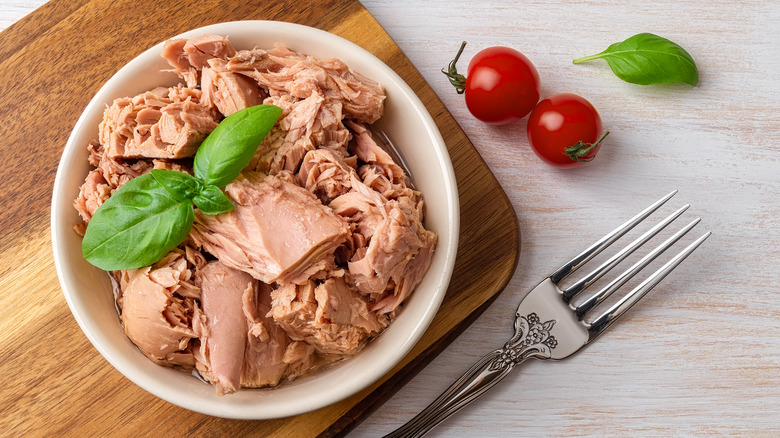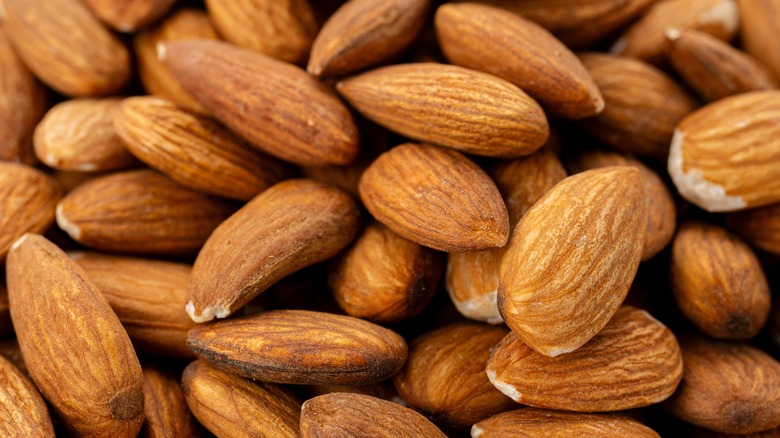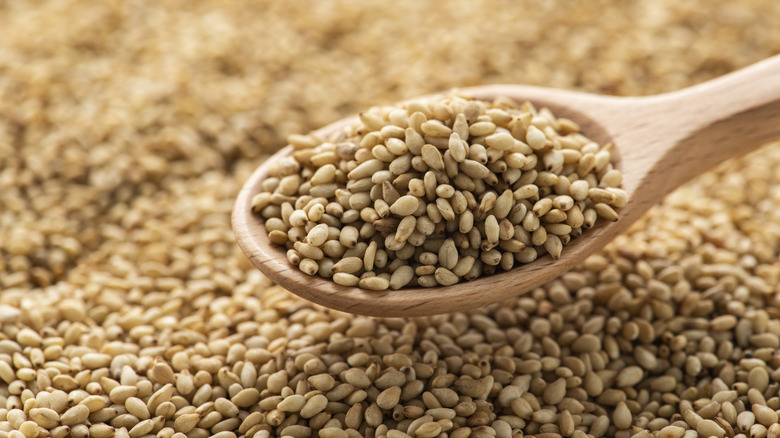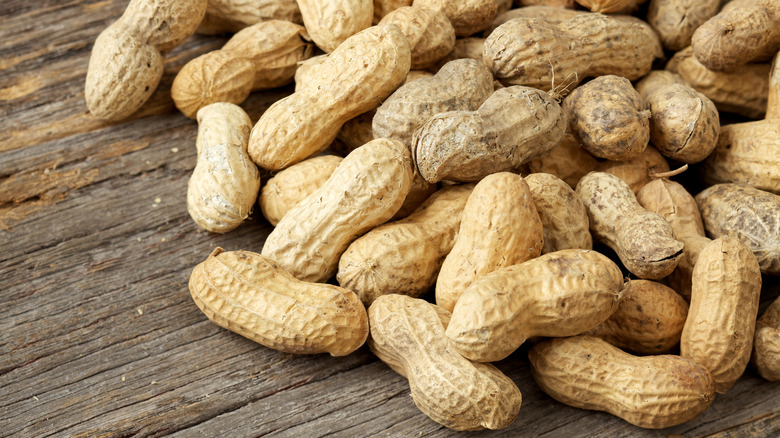Unexpected Foods That Can Cause Itchy Skin
If you asked a group of people what pruritus is, chances are very few would know. And yet, it's very likely they've all experienced it. As MedlinePlus explains, "pruritus" is the medical term for "itching," whether that itching occurs in just one area or multiple areas of the body. Besides that unpleasant sensation that usually leads to scratching, pruritus can be accompanied by hives or a rash.
Not surprisingly, there are quite a few things that can cause itching, says MedlinePlus. For example, getting bit by an insect can make one itchy. Parasites like head lice are another culprit. Different health conditions like psoriasis, eczema, shingles, and diabetes can cause this symptom. Diseases that affect the thyroid, kidneys, and liver can all cause itching, too, as can different types of cancers. Even being pregnant can be the reason behind itchiness, as can medicines and cosmetics, depending on their ingredients.
In some individuals, various foods can trigger allergic reactions, which can include itchiness as a symptom, per MedlinePlus. We will be exploring some of these food allergies, as well as some of their other possible symptoms besides itching.
Bread
While not all breads contain wheat, this ingredient is commonly found in many bread recipes. As the Mayo Clinic explains, a person with a wheat allergy can develop an itchy rash, hives, or swelling of their skin. In addition, someone with a wheat allergy might experience itchiness (as well as irritation or swelling) in their mouth or throat.
Other possible red flags of a wheat allergy can range from developing a headache and nasal congestion to issues like nausea, vomiting, cramps, and diarrhea. Also, a person with a wheat allergy might have problems breathing, but severe problems breathing can be a sign of anaphylaxis. Other signs of anaphylaxis include dizziness, fainting, blue skin, tightness in the chest and/or of the throat, chest pain, swelling of the throat, and problems swallowing. So, if you think someone is experiencing anaphylaxis, call for emergency medical help immediately.
While avoiding bread containing wheat is important if you have a wheat allergy, remember an allergic reaction can also occur from just breathing in flour made from wheat. Also, foods like ice cream and soy sauce can have wheat. Finally, having a wheat allergy is not the same thing as having celiac disease even though avoiding wheat is recommended for both health issues.
Cow milk
It's not common for adults to have a cow milk allergy, according to the Better Health Channel. In fact, it's far more likely that an adult will have lactose intolerance, which is a different health issue. But those who do have this type of allergy can experience not only an itchy rash but also one that is red, crusty, or weeping. In addition, a cow milk allergy can cause urticaria or what's more commonly known as "hives."
Keep in mind that even a small amount of milk can trigger an allergic reaction in a matter of minutes. Other immediate symptoms of a cow milk allergy can include vomiting, diarrhea, facial swelling, coughing, and wheezing. However, possible red flags of this allergy can also occur hours or even days after consuming milk. And, yes, cow milk can also cause anaphylaxis. No matter what symptom, or symptoms, someone experiences or how quickly they occur, the reason for them is the same: The protein in cow milk affects the immune system, which leads to the body releasing histamine. The histamine is why one develops health problems like the kinds listed above.
Of course, cow milk is just one type of milk product, but if you have a cow milk allergy, be careful. As the Better Health Channel explains, the milk from (for example) goats, buffalo, and sheep might also trigger an allergic reaction for cow milk allergy patients.
Tuna
While some food allergies are less common in adults than children, fish and shellfish allergies are just the opposite (per Better Health Channel). Although the symptoms can vary, itchiness is definitely a possible sign for these types of allergies. There are quite a few aquatic critters that could be the culprit behind this type of food allergy, including widely available fish like tuna.
Besides itchiness, tuna (as well as other fish and shellfish) can cause hives or rashes to occur if a person is allergic to them. They also might experience a tingling sensation inside their mouth and throat, as well as a tightening of the throat. In addition, their lips could become swollen, their nose could become runny, and they could have pain in their stomach. Vomiting can also occur; and, like with other allergies, a person who is allergic to fish or shellfish can experience anaphylaxis.
Now, it might seem like the secret to managing a fish or shellfish allergy is just to avoid a particular fish or shellfish if you have an allergic reaction to it. Unfortunately, it's not that simple since being allergic to one fish or shellfish could mean you're allergic to other ones, according to the Better Health Channel. The list of potential allergic reaction-causing fish includes not just tuna but also snapper, salmon, and cod. The same is true for shellfish, which are both crustaceans like crabs and mollusks like mussels.
Eggs
According to the American College of Allergy, Asthma, & Immunology (ACAAI), only about 30% of children who are allergic to eggs don't outgrow their allergy by the time they're in their mid-teens. However, if you do have an allergic reaction to the proteins in eggs, ACAAI points out that taking antihistamines might help with itchiness that can occur because of this allergy.
A person with an egg allergy can also experience hives, eczema, rash, or swelling of the skin even if they only touch eggs. Their skin can also become pale or blue. Problems like nausea, vomiting, cramps, and indigestion are also possible as is diarrhea. This allergy can also cause breathing problems like shortness of breath, wheezing, and a repetitive cough, as well as a runny nose and sneezing. In addition, egg allergy patients can have a weak pulse, red eyes, watery eyes, a hoarse voice, tightness in their throat, swollen lips and/or tongue, dizziness, and confusion. And, although it's not common, an egg allergy can cause anaphylaxis.
Of course, if you're allergic to eggs, you should cut them from your diet. However, eggs can be in foods you might not suspect like ice cream, salad dressings, and meatballs. And, if you think switching to egg substitutes is an instant fix, think again. Remember, it's the protein in eggs that triggers the allergic reaction, and these same egg proteins can be in some brands of egg substitutes.
Almonds
According to Food Allergies Atlanta, it's extremely common for someone to have a tree nut allergy. This means a number of foods can be off the table, including hazelnuts, pistachios, cashews, and almonds. While an almond allergy is often associated with childhood, technically, a person can develop it at any point in their life (per Food Allergies Atlanta). So, it's possible to one day find almonds suddenly make you itchy, give you hives, or make your skin red. Additionally, tree nut allergies can cause itchiness, specifically on the face, as well as in the mouth and throat.
Like other foods on this list, almonds can trigger more than just itchiness in an allergic individual. As Food Allergies Atlanta explains, an almond allergy can also cause one's face, tongue, or lips to swell. A person might also become nauseous and start vomiting if they're allergic to almonds. Other signs include diarrhea, coughing, wheezing, difficulty breathing, dizziness, fainting, and a sudden drop in blood pressure. Also, a person with this allergy (or any kind of tree nut allergy) can experience anaphylaxis.
Of course, anaphylaxis requires immediate medical help, per Food Allergies Atlanta. Epinephrine is used to treat anaphylaxis; but, even if it's administered immediately, don't hesitate to call 911. For less severe allergic reactions, you can try sipping water to flush out the allergen and/or using cold compresses. You can also try taking an over-the-counter antihistamine to relieve symptoms. But again, don't delay seeking medical help immediately for even a mild reaction.
Sesame seeds
Chances are you've seen sesame seeds on foods like hamburger buns. However, as WebMD notes, these little oilseeds aren't just a decorative touch. Their oil and paste can be ingredients for various food recipes (per WebMD).
According to Latitude Food Allergy Care, it's possible for someone with a sesame seed allergy to have a reaction within minutes of consuming them. However, not everyone will start displaying symptoms immediately after eating sesame seeds (including in other forms like paste and oil), notes Latitude Food Allergy Care. It could take hours for symptoms to begin and what symptoms occur can range from mild to severe. Itching, as well as hives or a rash, are possible signs of an allergic reaction to sesame seeds. Other possible signs to watch for include if the person becomes dizzy, starts wheezing, has shortness of breath, feels nauseous, starts vomiting, or experiences nasal congestion. Abdominal pain and diarrhea might also occur. The patient could also have swelling in the throat, mouth, or tongue, as well as on specific areas of the face (the lips or around the eyes).
Additionally, sesame seeds can cause anaphylaxis. If you or someone you know has a food allergy or allergies, Food Allergy Research & Education (FARE) recommends having FARE's Food Allergy & Anaphylaxis Emergency Care Plan, which lists specific instructions like medications and doses.
And one final note: Sesame seeds are also used in non-food products like cosmetics and medicines (per WebMD).
Soy
Like other items on this list, it's less likely for an adult to be allergic to soy than it is for an infant or a small child (per Cleveland Clinic). And the odds of having this allergy go up in general if a person is allergic to any other foods. But a sign that you might have this allergy includes feeling itchy after consuming soy.
Cleveland Clinic explains that, along with itching, a person who has a soy allergy might develop hives and eczema. Stomach problems like cramps, indigestion, nausea, and vomiting can also occur. This allergy can also cause coughing and tightness in one's throat. However, swelling in the throat and difficulty breathing can be red flags of anaphylaxis. Remember, a person experiencing anaphylaxis can go into shock, so don't hesitate to seek emergency medical help.
Now, in some cases, it's simple to tell what foods contain soy. For example, soy sauce literally has the word "soy" in its name, per the University of California San Francisco. However, not everything on the market is that obvious. Just a few examples of soy-containing foods include tofu, miso soup, and tempeh. Vegetarian alternatives for sausages, hot dogs, and burgers can also be sources of soy. Other ones to watch for include imitation bacon bits, vegetable broths, cereals, and meal replacement shakes since sometimes these foods contain soy. Finally, soy is sometimes used in medications, as well as topical products like lotions and soaps.
Peanuts
Peanut allergies are often (and rightfully) associated with anaphylaxis, according to the Mayo Clinic. There are a number of symptoms of a peanut allergy. Specifically, a person with this type of allergy might experience itchiness or a tingly sensation either around or inside their mouth and their throat. Hives, swelling, or redness are also red flags of a peanut allergy. And, while it might be days before someone has an allergic reaction to cow milk (per Better Health Channel), the symptoms of a peanut allergy typically happen not long after coming in contact with peanuts.
While consuming peanuts can trigger an allergic reaction, the Mayo Clinic notes that foods that don't contain peanuts can still be made in a place where there are peanuts and so could cause an allergic reaction. Just touching peanuts could also be enough to set off allergy symptoms. Plus, breathing in peanuts can be detrimental for a peanut allergy patient (Remember: Peanuts are used in products like cooking sprays and flour).
In addition to skin reactions, a person with a peanut allergy can experience symptoms like a runny nose, tightening of the throat, wheezing, and shortness of breath, per the Mayo Clinic. They also can have stomach cramps, nausea, vomiting, and diarrhea.
If food allergies run in your family and/or you have eczema or hay fever, you might be more likely to develop a peanut allergy. Also, childhood peanut allergies sometimes return in adulthood.









